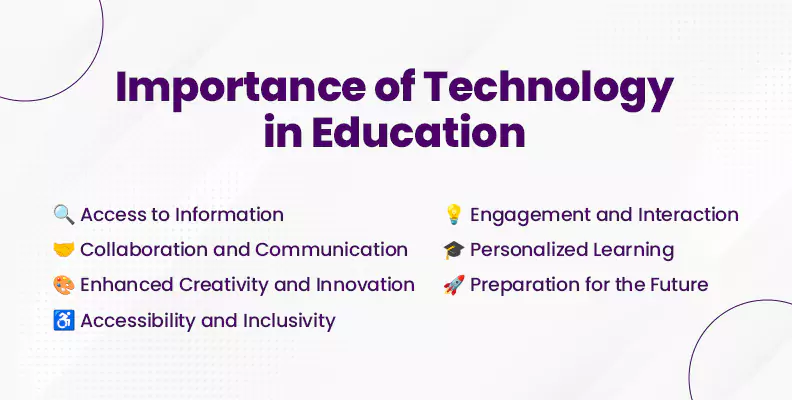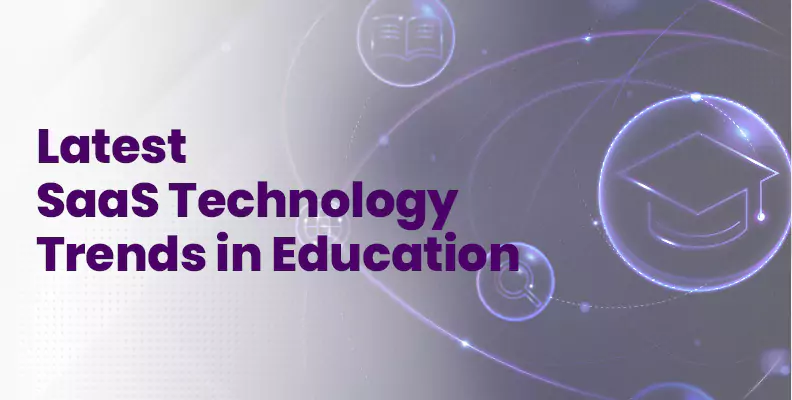Loading.....
Transformative Role of SaaS Technology in Education

Picture a classroom buzzing with excitement as students collaborate on a virtual project, accessing a world of knowledge at their fingertips. This scene encapsulates the transformative power of Software as a Service (SaaS) in education, where technology becomes the catalyst for curiosity, creativity, and collaboration. In an era defined by rapid technological advancement, SaaS emerges as a beacon of innovation, reshaping the way educators teach and students learn. Let's start on a journey to explore the profound impact of SaaS in education, uncovering its significance, navigating through challenges, and witnessing firsthand its remarkable influence on students' lives.
Importance of Technology in Education

Before diving into the specifics of SaaS, it's essential to understand the broader importance of technology in education. Technology has transformed education in numerous ways, offering innovative tools and resources that enhance the teaching and learning experience. Here are some key reasons why technology holds immense importance in education:
Why You Need SaaS Technology in Education
Among the various technological advancements, Software as a Service (SaaS) technology has emerged as a game-changer, revolutionizing the way educational institutions operate. From enhancing collaboration to streamlining administrative tasks, SaaS technology offers numerous benefits for educators, students, and administrators alike. Here are seven compelling reasons why SaaS technology is a must-have in education.
- Structured Schema: One of the most significant advantages of SaaS technology in education is its accessibility. With SaaS applications, students and educators can access learning materials, assignments, and collaborative tools from any internet-enabled device, be it a laptop, tablet, or smartphone. This accessibility transcends physical boundaries, allowing for seamless learning experiences regardless of location or time constraints.
- Accessibility Anytime, Anywhere: Relational databases adhere to the ACID (Atomicity, Consistency, Isolation, Durability) properties, which guarantee transactional reliability. ACID compliance ensures that database transactions are executed reliably and consistently, even in the event of system failures or concurrent access.
- Cost-Effectiveness: Traditional software installations often come with hefty upfront costs and ongoing maintenance expenses. In contrast, SaaS technology operates on a subscription-based model, eliminating the need for significant initial investments. Educational institutions can allocate their resources more efficiently, redirecting funds towards improving teaching quality and student support services rather than IT infrastructure.
- Scalability and Flexibility: Educational institutions experience fluctuating demands throughout the academic year, making scalability a crucial consideration. SaaS solutions offer unparalleled scalability, allowing institutions to adjust their usage levels based on current needs. Whether accommodating a sudden surge in student enrollment or scaling down during academic breaks, SaaS technology provides the flexibility to adapt seamlessly without disruption.
- Enhanced Collaboration: Collaboration lies at the heart of effective learning. SaaS applications facilitate collaborative learning environments by providing tools for real-time communication, document sharing, and group collaboration. Whether it's a group project or a virtual classroom discussion, SaaS platforms enable students and educators to collaborate effortlessly, fostering engagement and knowledge exchange.
- Streamlined Administrative Processes: Managing administrative tasks can be a time-consuming endeavor for educators and administrators. SaaS technology automates various administrative processes, such as student enrollment, grading, and attendance tracking, streamlining workflows and reducing manual workload. By freeing up time spent on administrative tasks, educators can focus more on personalized instruction and student support.
- Data Security and Privacy: Protecting sensitive student data is paramount in today's digital age. SaaS providers adhere to stringent security standards, implementing robust encryption protocols and data protection measures to safeguard confidential information. Additionally, SaaS platforms offer built-in backup and disaster recovery mechanisms, ensuring data integrity and continuity in the event of unforeseen circumstances.
- Continuous Updates and Innovation: SaaS technology thrives on innovation, with providers regularly releasing updates and new features to enhance functionality and user experience. Educational institutions benefit from access to the latest advancements without the hassle of manual software updates or installations. This ensures that educators and students have access to cutting-edge tools and resources to support their learning journey effectively.
Latest SaaS Technology Trends in Education

Personalized Learning Platforms
Personalized learning platforms are revolutionizing the educational landscape by tailoring content to the individual needs and learning styles of students. By providing adaptive assessments, targeted interventions, and customized learning paths, these platforms empower students to learn at their own pace and in their preferred style. As a result, students experience increased engagement, motivation, and academic success.
Collaborative Tools and Communication Platforms
SaaS technology enables seamless collaboration among students, teachers, and parents, fostering a sense of community and connectedness. Collaborative tools such as virtual classrooms and discussion forums facilitate peer-to-peer learning, knowledge sharing, and teamwork. Moreover, real-time communication platforms enhance student-teacher interactions, enabling students to seek help, ask questions, and receive feedback promptly, thereby promoting active engagement and deeper learning.
Cloud-Based Learning Management Systems (LMS)
Cloud-based LMSs provide students with anytime, anywhere access to learning materials, resources, and assignments. By centralizing course content and communication channels, these platforms enhance organizational skills, time management, and self-directed learning among students. Additionally, cloud-based LMSs promote collaboration and teamwork by facilitating group projects, peer reviews, and collaborative learning activities, preparing students for success in the digital workplace.
AI-Powered Educational Assistants
AI-powered assistants support students in various aspects of their learning journey, from providing personalized tutoring to assisting with homework assignments. These assistants adapt to students' individual needs and preferences, offering tailored recommendations, explanations, and practice exercises. By receiving immediate feedback and guidance, students can address their learning gaps, build confidence, and achieve better academic outcomes.
Data Analytics for Performance Tracking
Data analytics tools enable educators to monitor students' progress, identify learning trends, and intervene proactively to support struggling students. By analyzing data generated from assessments, interactions, and learning activities, educators gain insights into students' strengths, weaknesses, and areas for improvement. Moreover, data analytics facilitate evidence-based decision-making, enabling educators to refine teaching strategies, allocate resources effectively, and personalize learning experiences to meet students' diverse needs.
Virtual Reality (VR) and Augmented Reality (AR) Applications
VR and AR technologies offer immersive and interactive learning experiences, allowing students to explore complex concepts in a simulated environment. These technologies bring abstract concepts to life, making learning more engaging, memorable, and impactful. Whether it's conducting virtual experiments, exploring historical landmarks, or simulating real-world scenarios, VR and AR applications spark curiosity, creativity, and critical thinking skills in students, enhancing their overall learning experience.
Cybersecurity and Data Privacy Measures
Protecting students' privacy and ensuring the security of their data are paramount concerns in the digital age. SaaS providers implement robust cybersecurity measures, such as encryption, access controls, and regular security audits, to safeguard sensitive student information from unauthorized access and breaches. Moreover, compliance with data protection regulations ensures that students' privacy rights are upheld, fostering trust and confidence in educational SaaS platforms.
Conclusion
In conclusion, SaaS plays a pivotal role in transforming education, offering innovative solutions to enhance teaching and learning experiences. While challenges exist, the potential benefits of integrating SaaS in education far outweigh the obstacles. By embracing SaaS technology, educators can unlock new possibilities, empower students, and prepare them for success in the digital age.
 Back to blog
Back to blog












